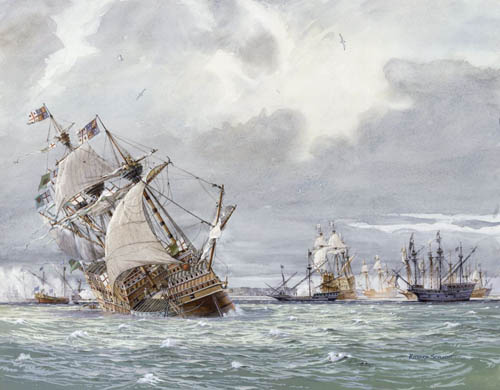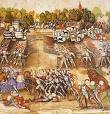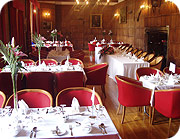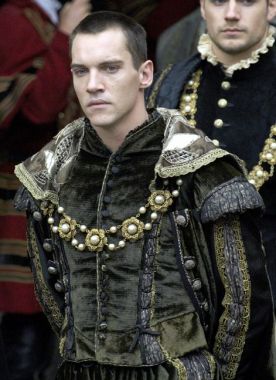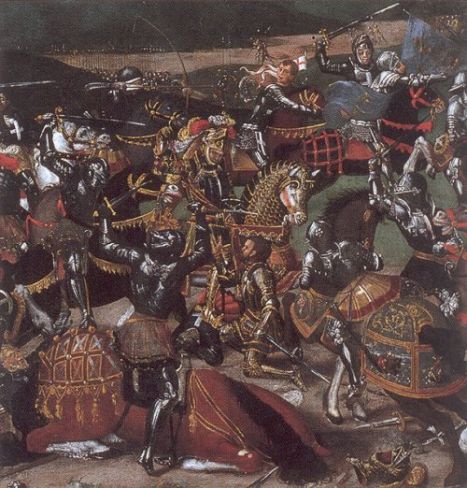Battles during Henry's reign
Jump to navigation
Jump to search
Historic Battles duringKing Henry VIII"s Reign
FLAGSHIP of Henry VIII"s navy | |
| The Europe of the early 1500s was a confused conglomeration of disputes and dynastic claims, with few settled borders.The most important players were the French Valois dynasty and their main continental rivals, the Habsburgs, who controlled a huge swathe of central Europe. Henry, galvanised by tales of English hero-kings, was eager to grab a piece of the action. He wanted to build an empire of his own, and military victories meant more cards to play at the next round of negotiations, when new alliances were agreed, lands were exchanged and marriages arranged.[source: Historical Royal Palaces] | |
The Battle of the Solent Naval Battle which took place on 18 and 19 July 1545 | |
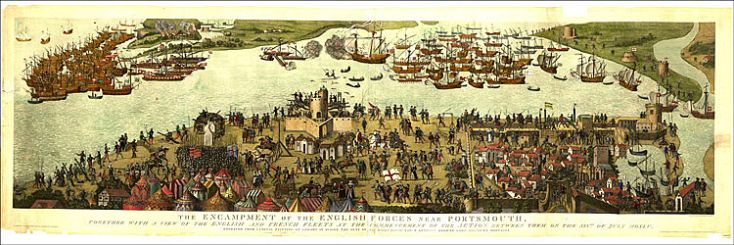 Cowdray Engraving of the Battle of Solent "In July 1545 the French fleet entered the Solent with the intention of invading the Isle of Wight and destroying the English fleet. The French voyage started in farce. On July 6th Francis I dined on the flagship Carraquon, after he left it was destroyed by fire. Admiral Claude d'Annebault shifted his flag to La Maistresse, which promptly ran aground on leaving port. Patching up the leaks, the fleet sailed for the Isle of Wight. The French fleet was huge, with 200 sail, including 23 of the galleys that had proved so effective in 1513.The English fleet that met them consisted of around 80 ships, gathered in Portsmouth, with more expected from the west Country. The English aimed to fight a defensive battle, they were outnumbered, but had a positional advantage. The first day of the battle consisted of a long range cannonade between the French galleys and the English fleet in which neither side suffered any real loss. The French had also invaded the Isle of Wight, tangling with the local militia. At about this time the French Admiral had to move his flag again, La Maistresse was sinking from the damage incurred by running aground, although she was later repaired. That night, Henry dined on the flagship, Henry Grace a Dieu, with the admiral, Viscount Lisle, as well as Sir George Carew, the newly appointed vice-admiral, and his senior captains. .... There are several versions of what happened on the 19th of July 1545. According to the French, at dawn their galleys took up the battle, trying to lure the English within range of their main fleet. The flat calm allowed them to pound the English ships with relative impunity. Suddenly, much to their delight the Mary Rose heeled over and sank. The French naturally believed they had sunk her. The Imperial ambassador, Van Der Delft, tells a rather different story. According to him, the French fleet appeared while the King was at dinner on the flagship. Henry went ashore and the English fleet was engaged by five galleys. He records that the Mary Rose sank towards evening, drowning all the 500 men aboard save about 25 or 30. Interestingly, he received a survivors account. "Was told by a Fleming among the survivors that when she heeled over with the wind the water entered by the lowest row of gun ports which had been left open after firing." [Source and for more read : <a class="external" href="http://www.maryrose.org/ship/history13.htm" rel="nofollow" target="_blank" title="maryrose.org">maryrose.org</a>] | |
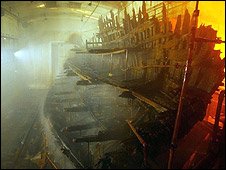 "Henry VIII's flagship Mary Rose was sunk by a French cannonball and this was covered up by political spin, according to a new academic study. Until now it was believed a combination of wind and tide pressed Mary Rose over, causing her gun ports to flood in a 16th Century battle in the Solent. But University of Portsmouth geographer Dominic Fontana said the truth was withheld to maintain the Navy's image. Mary Rose sank with the loss of more than 400 lives on 19 July 1545. By claiming the ship was toppled by wind and an incompetent crew, the Navy's supremacy was maintained, Henry VIII's pride remained intact and the French were unable to claim victory, said Dr Fontana."The Mary Rose was holed by French gunfire received from an advance party of fast, oar-powered galleys which were heavily armed," he said."She would have quickly taken quite a quantity of water into her hull before she manoeuvred to bring a broadside of guns to bear on the attacking French galleys." That fateful manoeuvre was her undoing he said because the sudden movement of water in the hold caused her to capsize. Dr Fontana, a former photographer who worked on the Mary Rose project, used Geographical Information Systems (GIS) technology to create a map from the Tudor Cowdray Engraving of the battle in the Solent. "The Mary Rose dropped into exactly the correct place where she sank," he said. "It showed that the Cowdray Engraving gave a really good geographical impression of what went on." He then integrated this data with tidal currents hour by hour over the period of the battle. Dr Fontana said: "Mary Rose was hit by French gunfire and despite valiant efforts being made by her crew she capsized just one mile from Southsea Castle from where King Henry VIII was watching."Thoseonshore would not have known anything about flooding in the hull caused by a French hit on the ship and it would have appeared as though she had been caught by a freak gust of wind and blown over." Mary Rose sank after 34 years of service, fighting in two wars against the French and one against the Spanish. She lay on the seabed for over 400 years. Then, in 1967, archaeologists diving in the area where she sank discovered the wreck. Millions of people watched the salvage operation on television in 1982. String of theories A spokeswoman for The Mary Rose Trust, the charity that preserves the ship, said the new research was the latest in a string of theories on the fate of the warship.Dr Fontana added that tools and skeletal remains found in the hold show men, who would otherwise not have been there in the middle of a battle, were working in the dark to plug the hole made by the cannonball.Christopher Dobbs, archaeologist at the Mary Rose Museum, said: "As archaeologists, we have studied the remaining evidence from the ship."But, as we have nothing left of the port side, it is helpful for people from other fields to contribute their own theories and ideas." Source: <a class="external" href="http://news.bbc.co.uk/2/hi/uk_news/england/hampshire/7733296.stm" rel="nofollow" target="_blank" title="BBC News">BBC News </a> | |
The Battle of Ancrum Moor 27 February 1545 | |
The English are defeated by the Scots at Ancrum Moor. | |
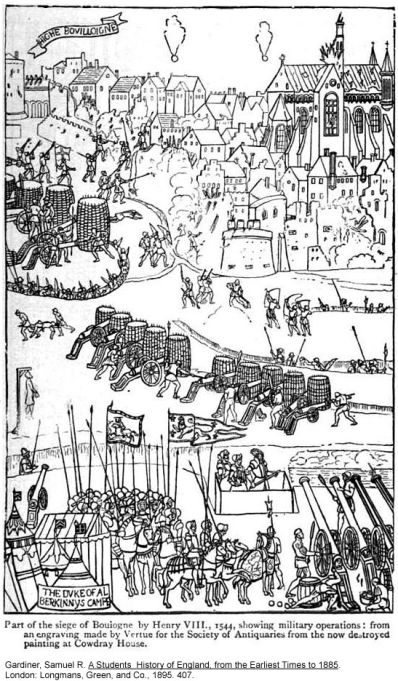 THE CAPTURE OF BOULOGNE (Sept. 14, 1544) by the English, the one important result of the combination of King Henry VIII and Charles V for the subjugation of France in 1544, after a protracted siege of nearly two months. According to the original plan of the campaign, Charles was to strike across France by Champagne, Henry by Picardy, and neither was to stop till he reached Paris, where, in their united might, they were to dispose of the French monarchy. The first thing, however, that Henry did was to sit down with the bulk of his army before Boulogne; and when Charles reproached him for not adhering to the method of invasion determined upon between them, Henry retaliated by accusing Charles of a similar breach of their contract. The siege of Boulogne is principally memorable for the length of the resistance made by the garrison under the disadvantageous circumstances of weak fortifications, and besiegers strong in numbers and offensive engines. After the capitulation they were allowed to march out with their arms and property; whereupon, according to Hall's Chronicle, "the king's highness, having a sword borne naked before him by the Lord Marquis Dorset, like a noble and valiant conqueror, rode into the town, and all the trumpeters, standing on the walls of the town, sounded their trumpets at the time of his entering, to the great comfort of all the king's true subjects." The town was restored to the French on the conclusion of peace (1550). [Source: <a class="external" href="http://www.luminarium.org/encyclopedia/boulogne.htm" rel="nofollow" target="_blank" title="luminarium.org">luminarium.org</a>] | |
The Battle of Solway Moss
| |
The Scots are defeated by the English. A more appropriate term may be the “Skirmish at Solway Moss,” since the Scottish army put a weak effort at best, to defeat their long time enemy, the English. James V was scheduled to meet with his Uncle, King Henry VIII at York in while the English king was on his summer progress in 1541. Henry, who rarely ventured to the northern realm of his kingdom, traveled to York specifically to meet his nephew. James V wanted very much to travel south to England and meet his uncle, but at the last minute the Scottish parliament forbid the king to go. They were afraid James might be kidnapped and held hostage in England. Henry VIII, always overly sensitive, took the snub as personal and vowed vengeance. In August of 1542, the Scottish won a victory over the English at Haddon Rig. The victory would be short lived. James V wanted to continue the winning streak by invading England. His nobles, however, did not agree with their king. After calling them a bunch of them all “faint hearted” James left Edinburgh on November 21, 1542 for the border with Cardinal Beaton and his last noble minion, Oliver Sinclair. Sinclair took charge of the 14,000-20,000 men, leading them from Langholm toward the River Esk. The English forces, led by Sir Thomas Wharton, quickly routed the Scots back, to Solway Moss, a swampy plain. A handful of Scots were killed, but for the most part the Scots help up their swords and gave themselves up. Approximately 1200 Scots were captured for ransom. The Scottish nobles that did accompany the mission opted for being taken hostage rather than death, because they had left so little faith left in James V. |
| The Battle of Flodden Field 7-9 September 1513 |
Fought in the county of Northumberland in northern England , between an invading Scots army under James IV of Scotland and the English Army under Thomas Howard, 2nd Duke of Norfolk. James IV was killed and succeeded by James V who was an infant. His mother, Margaret Tudor (sister to Henry VIII), took over as Regent. |
| King James IV of Scotland |
|
| Flodden Field and Brankston Hill in the heat of battle |
|
| Thomas Howard Earl of Surrey Restored as 2nd Duke of Norfolk |
|
| Ford Castle Ford Castle Courtyard The Great Dinning Hall at Ford Castle |
_______________________________________________ Bibliography:
|
The Battle of The Spurs 16 August 1513 |
Henry VIII led an army of 35,000 from England and lands at Calais. The Battle of Spurs (which was so called because the French cavalry fled without fighting at Therouanne (August 16), and merely surrendered six days later. |
| As a young king, Henry VIII got one of his first tastes of furious, hot, bloodied swords at Therouanne. (Kind of, but not really.) Considering the delicate nature of his new position as king and with no living heirs, this was an ideal situation to let Henry stretch his battle arms, with out getting one cut off. Henry VIII was positioned clear from the battle field as to avoid and real danger. | |
| On August 16th, 1513 King Henry VIII staged his soldiers to storm and conquer the small and very vulnerable Therouanne. | |
| The French Cavalry was positioned and ready to fight! Within the first moments of the the English Attack, The French realized there was no hope for victory. Due to the speed of the French flee, the day would be forever remembered as the Battle of Spurs! With in a few weeks of the retreat, the town fell under control of The English. | |
Bibliography:
|
LINKS:
| LITERATURE:
|
